Digital Designer
Chau Chak Wing Museum Redesign
Enhancing the Museum Experience Through The Creative Thinker Quiz

MY ROLE
User Experience Designer, UX Researcher
MY RESPONSIBILITY
- Conduct research, user testing, and analyse research insights
- Create sketches to communicate design concepts, define design parameters, and generate high-fidelity user journey map
- Present design proposal to the Chau Chak Wing museum for a potential to get implemented
TOOLS
Figma, Adobe Illustrator
PROJECT OVERVIEW
The Creative Thinker Quiz is a a semester-long User Experience studio project and a collaboration with the Chau Chak Wing museum (CCWM). At the time, the COVID pandemic has changed the museum experience significantly. International visitors have not been able to visit; local visitors have been required to maintain COVID-safe practices when visiting; and exhibits with interactive touchscreens have been closed off. This experience has highlighted the need to ‘future-proof’ the museum.
CCWM wanted to reimagine how visitors (both face to face and virtual) navigate, interact and learn from the physical and digital spaces of CCWM. My team decided to approach the brief using a path to serendipity which is finding an unexpected value during the museum visit so that the visitor might be more likely to want to repeat the experience in future, creating a stronger attachment to the museum.
Problem Statement
The problem statement from the big design brief was : How might CCWM use serendipity to future-proof the museum and create a stronger connection between visitors and objects?
Target Audience
The museum welcomes all visitors free of entry so that everyone can come to the museum to learn. But despite its availability, the CCWM had been experiencing a lack of visit, especially amongst the 18 to 21 year-olds who are in the Generation Z ( it was stated in an interview session with the museum staffs ).
The Process
To tackle this problem we used the Double Diamond method. We did extensive research on our target market and develop our solution through testing and iterations. Our primary research method was context mapping, which is a technique that falls in the category of generative techniques.
Our objective was to have a deep-dive into our target audience and find out what makes a memorable museum experience through a research method that enables them to think deeply.
Here is a link to see our research plan, context mapping research outcomes, and research visualization process: download here.
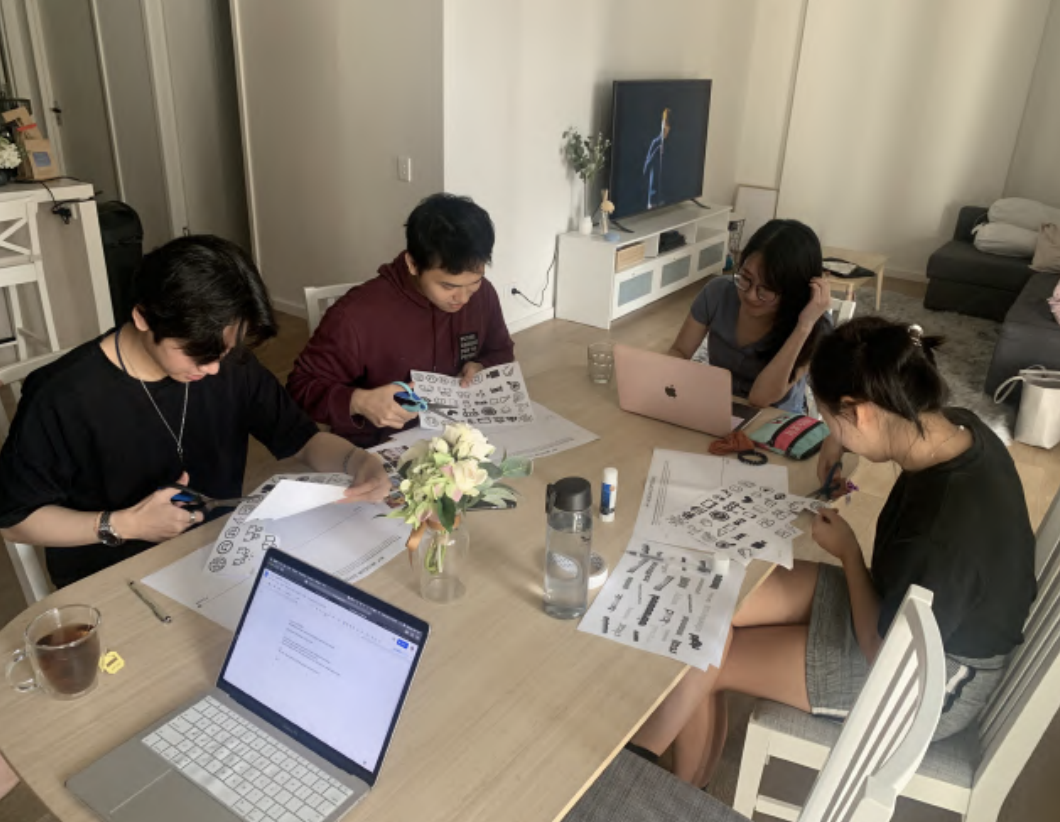
Context Mapping Research
- Young visitors easily recollect moments from museums where there were unique and inspiring designs that stood out to them. They appreciated the effort put into designing something innovative and different, as well as the insights they gained from the design.
- Young visitors wanted to know more about the artefacts that were presented; however, there was not much context given for every artefact. Thus, any object, decoration, or interior design that provided more context to the artefact amused and inspired the visitors.
- Young visitors want to learn something new through unexpected experiences. Through our context-mapping research, we noted that many of our participants, especially when going individually, visit museums to be impressed and find inspirations without knowing what would impress or inspire them. Generation Z are a culturally expressive and creative group of people. Thus, they are constantly looking for things that could spark creativity and innovative ideas. If museums were able to meet this need, participants would show satisfaction for that museum experience.
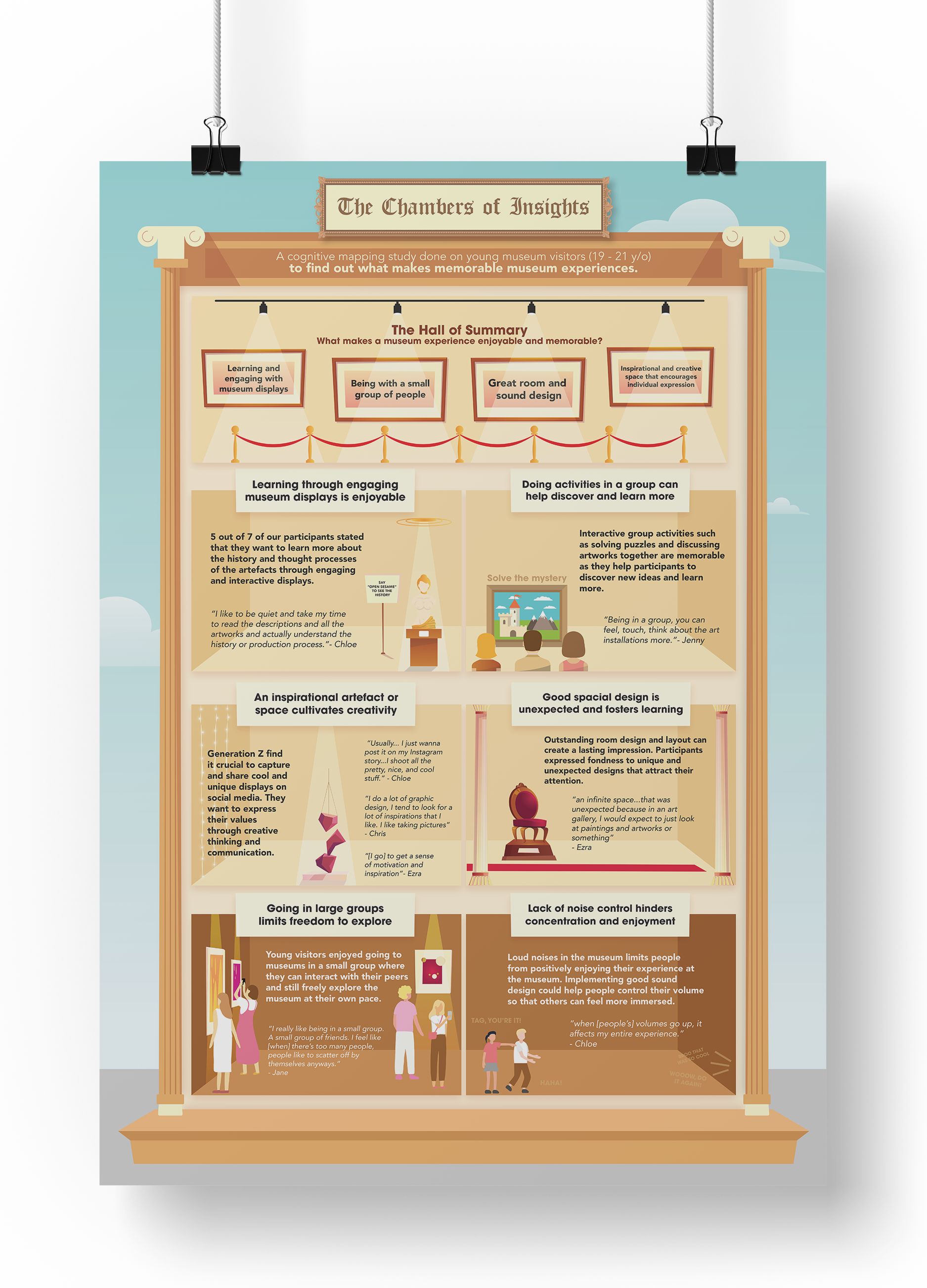
Our Vision
- Feed people’s desire to learn
- Foster creative and fun ways of learning
- Provide more context through supplementary devices, objects, designs, etc. to enhance the learning experience
A place that sparks creativity and revolutionary insights by fostering innovative ways of learning.
Vision Metaphor
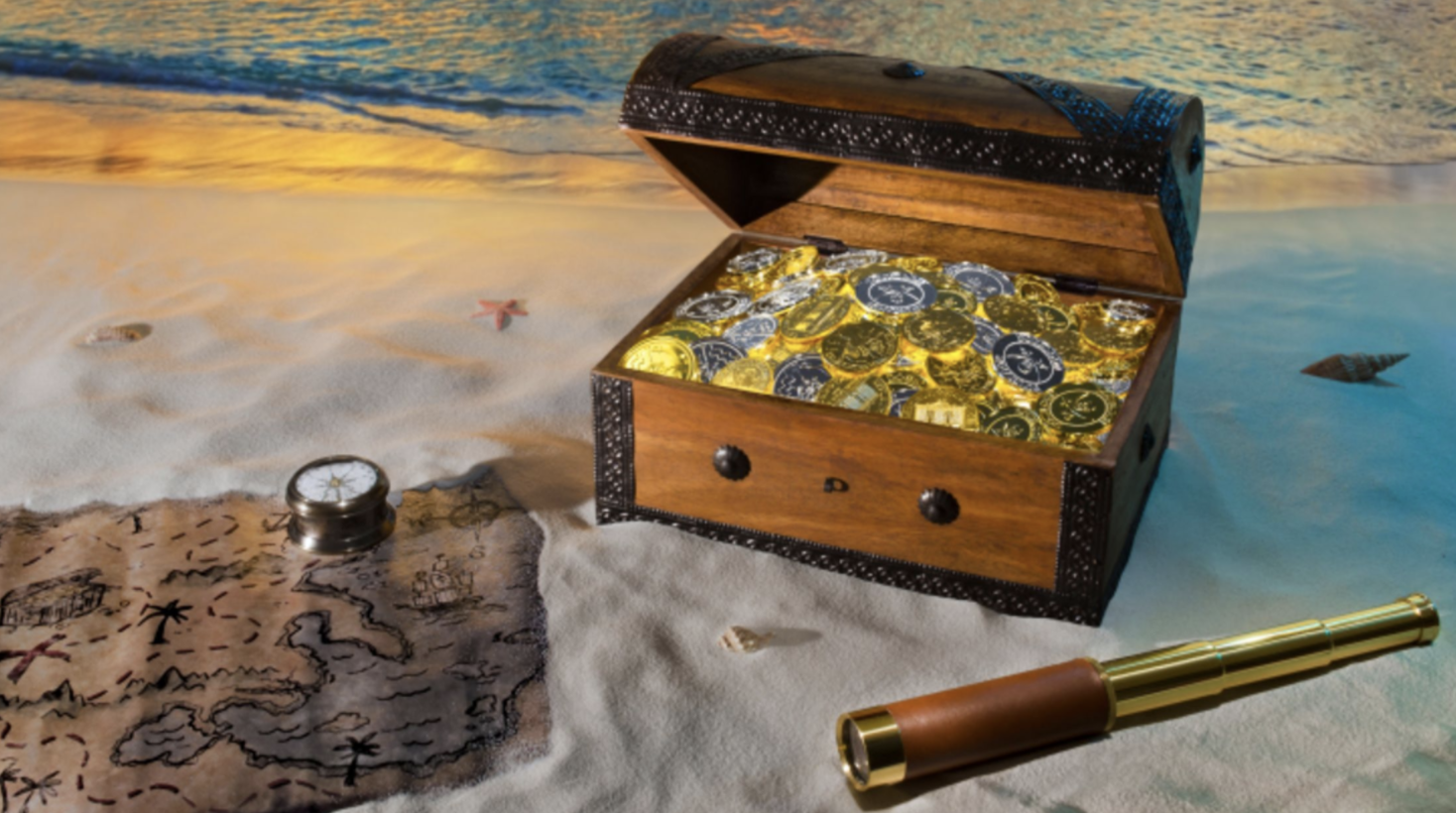
Waking in the museum is a treasure hunt for creative insights
Utilising the Vision in Design (ViP) design approach introduced by Hekkert et al in “Dancing with a Machine: A Case of Experience-Driven Design”, a vision metaphor was produced in creating design parameters that could be used for future developments of the Chau Chak Wing museum.
As described by Hekkert, one of the crucial steps in the ViP approach is describing the interaction between the user and the to be designed product through a design metaphor (Hekkert, 2003). According to Tomistch, metaphors can be applied in design to explore the problem from unusual perspectives, revealing the hidden dimensions of a problem to be solved (Tomisch, 2019).
Thus, our design metaphor for this design brief is similar to a treasure hunting experience. Walking inside a museum is a treasure hunting journey in itself, and visitors get to find that exuberant joy once they find the “treasure”— creativity and revolutionary insights through an exciting adventure of looking at millions of displays. Moreover, it is thrilling, as they never know what they will experience along the way.
Design Parameters
Based on the design metaphor, interaction characteristics were identified:
- Exploration. The museum invites the visitor to explore and learn more to find creative insights.
- Fascination. The museum displays are fascinating or creative enough to inspire visitors.
- Anticipation. The museum brings anticipation for the visitors to discover and learn new things
In order to establish the interaction described above, the museum must have features or characteristics that provide this multifaceted experience. The museum is amusing and impressive, thus, allowing the visitors to gain creative insights along their journey. The museum is inviting and anticipating, and it showcases a welcoming design that makes the visitors want to learn and discover deeper.
Concept Development
During our concept development we initially created four different ideas using storyboard and sketches that we showed to our tutors and peers. Based on the feedback and the decision matrix that we made, we chose “The Creative Thinker Quiz”.
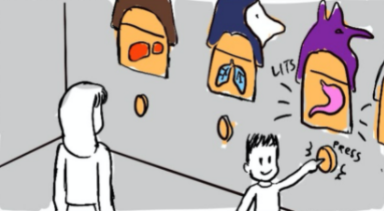
Interactive Wall Display
Audience ★★☆☆☆
Attractiveness ★★★★★
Feasibility ★★☆☆☆
Future proof ☆☆☆☆☆
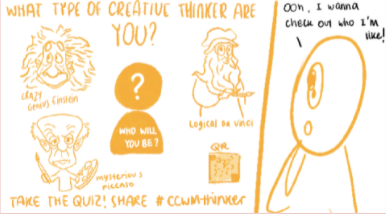
Creative Thinker Quiz
Audience ★★★★★
Attractiveness ★★★★★
Feasibility ★★★★★
Future proof ★★★★ ☆

Cubicles of The Past
Audience ★★☆☆☆
Attractiveness ★★★★★
Feasibility ★★★☆☆
Future proof ☆☆☆☆☆
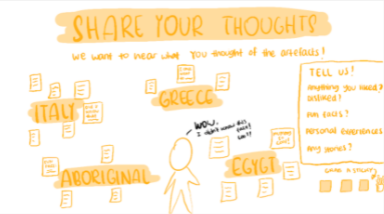
Wall Of Thoughts
Audience ★★☆☆☆
Attractiveness ★★★☆☆
Feasibility ★★★★★
Future proof ☆☆☆☆☆
Choice of Design
What is the Creative Thinker Quiz?
- A quiz to determine what “Type of Thinker” you are
- Inspired by (MBTI) 16 Personalities Test and Spotify Wrapped
- Visitors can share their quiz results on social media (i.e. Instagram story)
User Journey Map
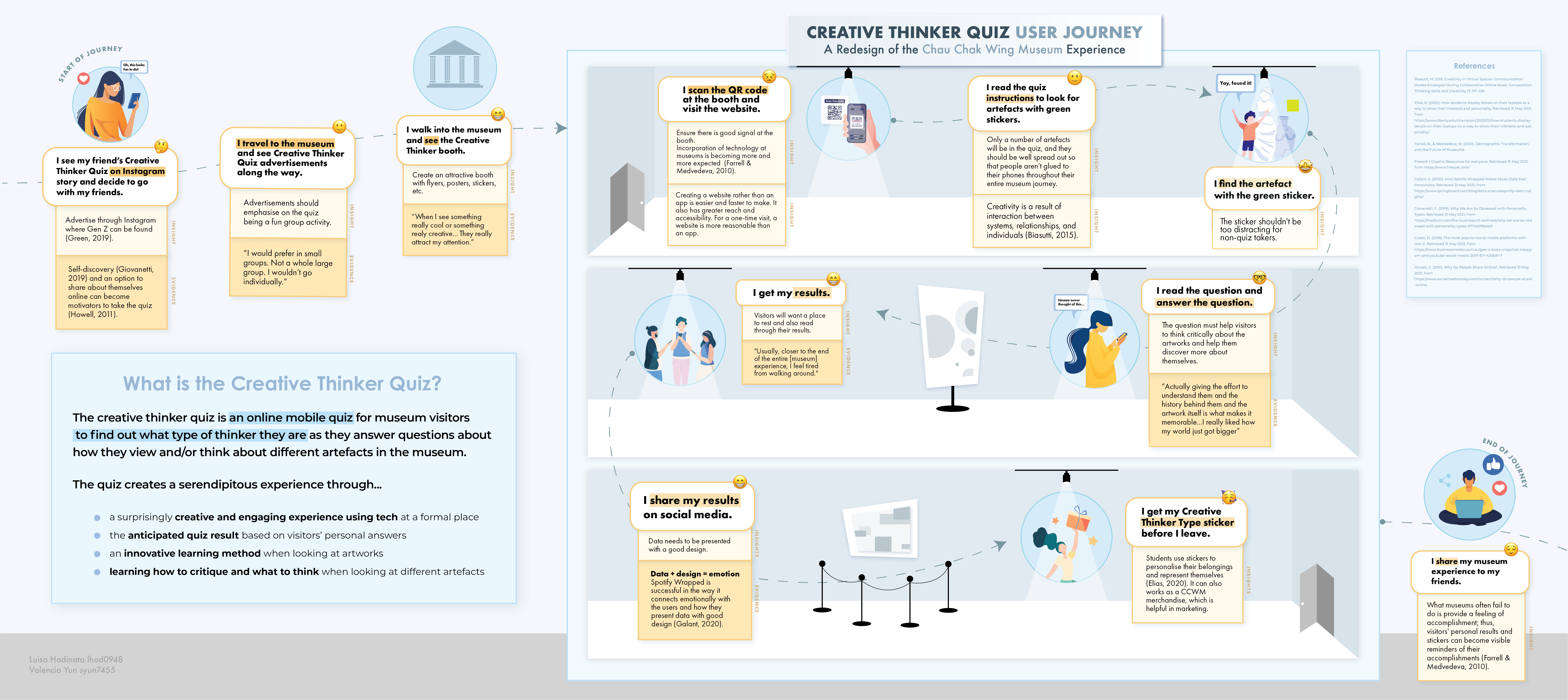
Feedback and Iteration
Based on the feedback that we were given by our tutors and peers, we found that:
- The concept is not distinctive enough.
- It needs to be more personalised & customised
Iteration that we did:
- Giving visitors stickers based on the artefacts and the visitor’s creative thinker type that act as a memo. Businesses use stickers as part of their marketing strategy to attract customers.
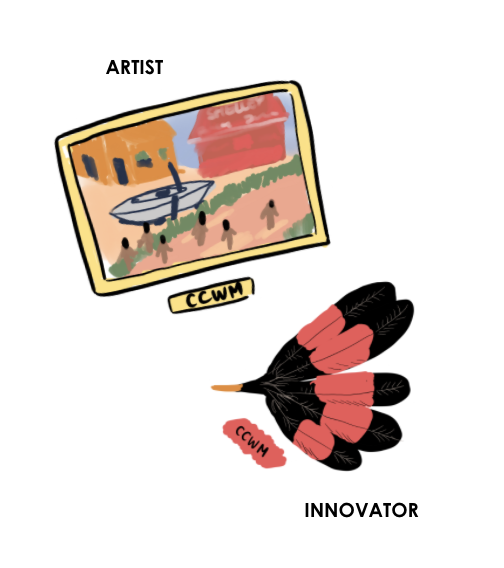
Reflection
This User Experience design studio was truly an amazing learning experience. To solve the design brief, our team decided to tackle down the problem by creating vision metaphors and design guidelines based on our generative context mapping research. From there, we develop our concept and user journey map through iterations.
Big thanks to my amazing teammates: Valencia Yun, Nicole Moran, and Milla Kim. Special thanks to our mentor and tutor, Leanne Wei Yi Ng who gave us excellent guidance throughout this project. Couldn’t have done this studio project without these amazing people!😊
Let's Work Together!
Don't hesitate to contact me if you have any inquires! I'm best reached through Linked In or email.